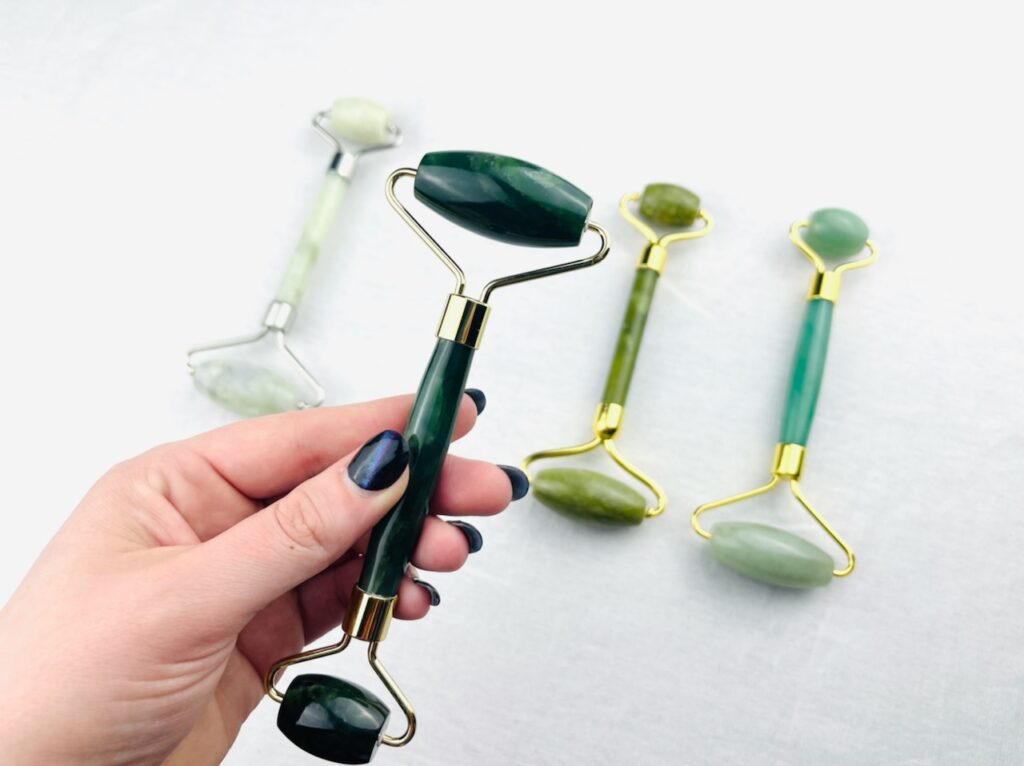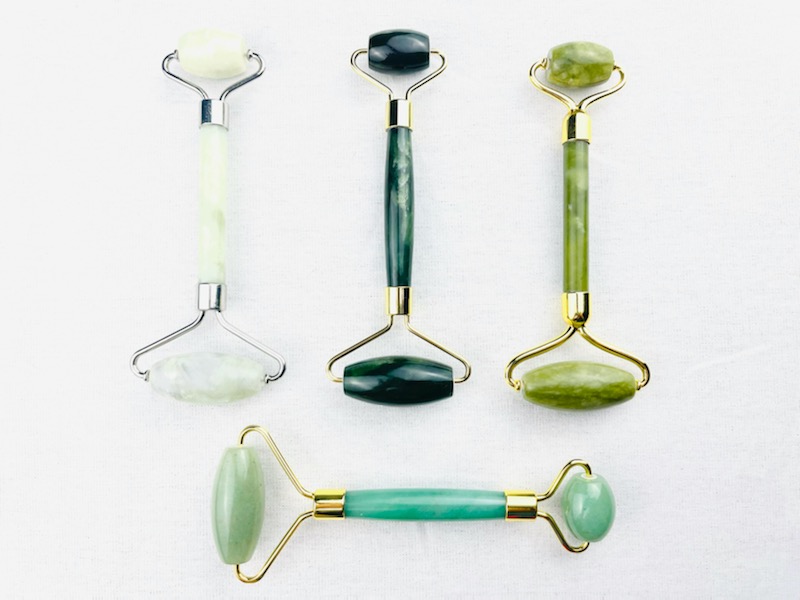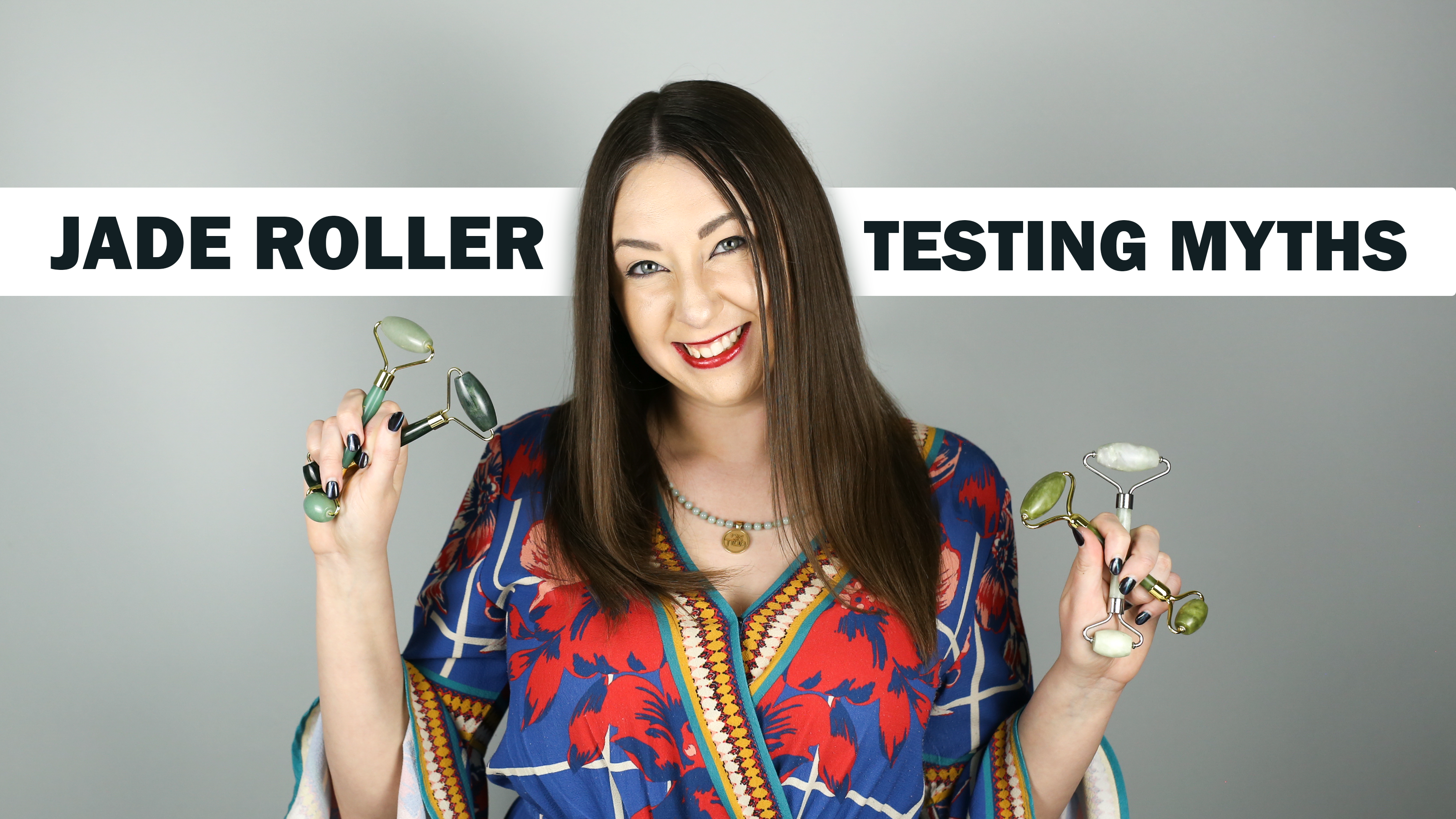REAL OR FAKE
Are Jade Rollers made from REAL Jade?!
To anyone who knows how rare and valuable jade can be, it’s probably no surprise that most jade rollers found in stores are actually quartz or some other simulant.
I’ve scoured the internet for information regarding the authenticity of jade rollers and predominantly found erroneous information that seems to imply jade rollers are commonly genuine.

HOME-TESTING MYTHS
Here are some of the common myths regarding jade roller authenticity and the truth behind them.
Myth #1: If you drop a jade roller and it breaks, it is probably real.
Fact: Jade is harder to break than almost all other gemstones.
Jadeite and nephrite are two of the toughest natural minerals on the planet. Can they break? Sure! But if they can, so can their simulants which are irrefutably less tough.
The most common jade simulant on the market is quartz which can also break if it drops on a hard surface, and is definitively more likely to break than jade.
Please don’t drop your jade roller. Whether or not it breaks is dependent on a variety of factors including height, angle of impact, the surface it lands on and more. Whether your jade roller is real or fake it can break, and truthfully it is less likely to break if it is jade rendering this myth extremely misleading. (Marketing, am I right?)
Myth #2: Color is an indication of authenticity.
Fact: Simulants can be dyed to mimic jade color.
It’s 2021 and there are some damn good fakes on the market — particularly in quartz. Fake jade can be painted, dyed, and made to look quite like jade. Colorless quartz can be dyed any color that jade can be and that’s a fact.
Unless it definitely looks like it’s not jade (for instance, if it is pink or some other non-jade color), color is not a reliable indicator. I strongly suggest taking a look at the Mason-Kay Jade Colors of Jade Chart.
Myth #3. If a jade roller is cool to the touch, it’s genuine.
Fact: Quartz and many other simulants can also be cool to the touch.
While jade is cool to the touch, it can warm up — particularly from contact with skin. With this being said, jade can be warmed and simulants can be cool. Temperature is not a reliable indicator.
Myth #4. You should look for Jade Rollers that say “natural jade.”
Fact: People lie. A lot.
Plenty of simulants are touted as “natural jade,” “imperial jade,” and even called “jadeite” and nephrite.” As it turns out, people do lie sometimes.
Myth #5. If your facial roller doesn’t scratch with a knife, it’s genuine jade.
Fact: Quartz is as hard to scratch as jade is.
The reason people use a “scratch” test is because steel is typically a 5-ish on the Moh’s Scale of Mineral Hardness. Because nephrite is a 6-7 on the hardness scale and jadeite is a 6.5-7 on the hardness scale, they can both scratch steel but not the inverse. Regardless, the absence of a scratch on your facial roller is not conclusive testing as quartz is actually a 7 on the hardness scale. This means that a stainless steel knife can’t scratch quartz, and therefore can not distinguish jade from quartz.

HOW TO TELL IF YOUR JADE ROLLER IS FAKE
Here are some common indicators that a jade roller is not natural jade:
-Low Price. If it’s $20 or $30, it’s probably not jade. However, with that being said, it might not be jade if it’s $80 either. Simulants are sold at all price points.
-Not a Reputable Seller. If you purchase a jade roller from a jade miner that actually sells jade jewelry, it’s a lot more likely that they’re selling genuine jade than a beauty store or online skincare seller. Naturally, skincare professionals don’t tend to be gemologists. It’s not their fault, that’s just how it is. Many quartz facial roller sellers believe they’re selling jade because they don’t have access to the ability to test it.
-Scratches with a Knife. Be careful with this, just because it isn’t jade doesn’t mean you can’t still use it. If the scratch test reveals it isn’t jade and you damage your facial roller in the process, you may render it unusable.
SIMULANT NOMENCLATURE
Here are some misleading words commonly used for jade simulants in facial rollers:
Dongling Jade, sometimes used for quartz
Aventurine Jade, used for aventurine quartz which is not jade
Chinese Natural Jade, may even come with a “certificate of authenticity” but this is not a quarantee
Xiuyan Jade
And many more!
WHERE TO FIND REAL JADE ROLLERS
The majority of jade rollers on the market simply aren’t natural nephrite or jadeite.
However, this doesn’t mean you can’t get a real one! In fact, Canadian nephrite miner Jade West produces a genuine jade roller which can be purchased at jademine.com
We have tested and proven that Jade West’s jade roller is in fact natural, genuine nephrite jade. It is also beautiful, well made, and feels incredible on the skin.
Beware of uneducated bloggers and skincare specialists commenting on jade authenticity. Jade is a complicated stone that many people do not understand due to confusing nomenclature and manipulative marketing. If you ever have any questions about jade, please contact a jade specialist such as Mason-Kay Jade (jadeite) or Jade West (nephrite.)
For other trustworthy resources on jade, visit:
https://www.gia.edu/gems-gemology

